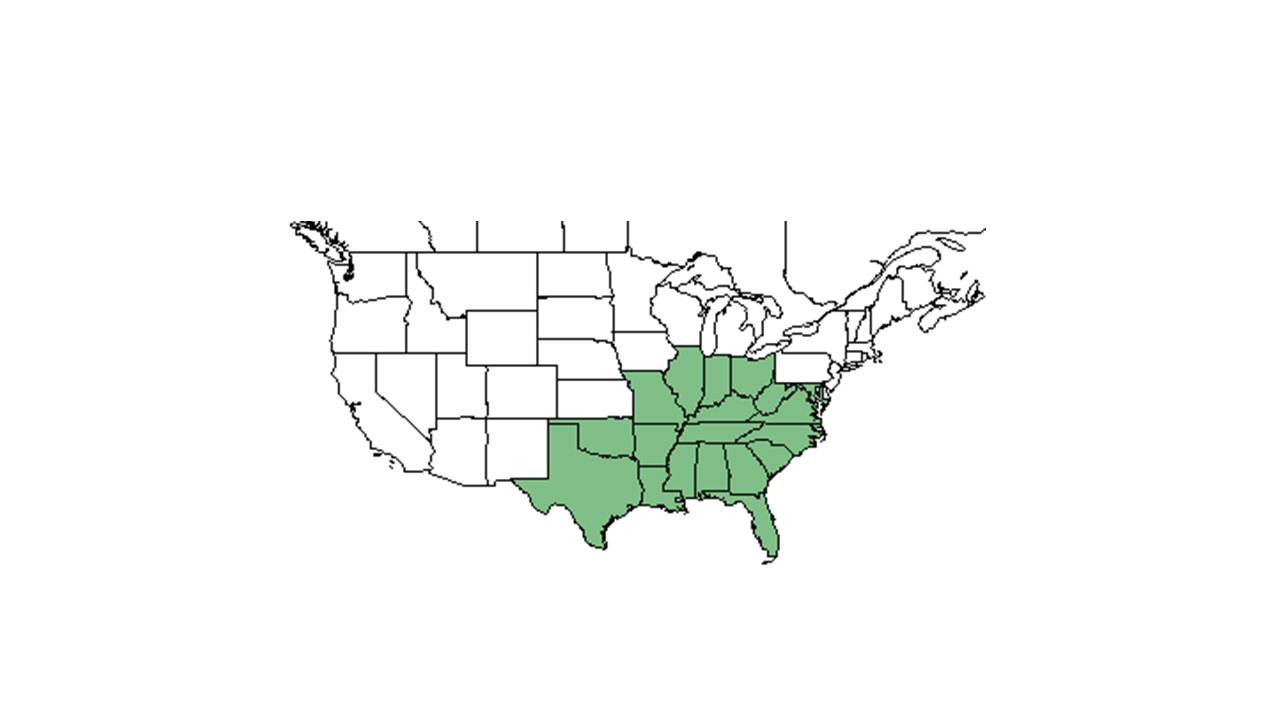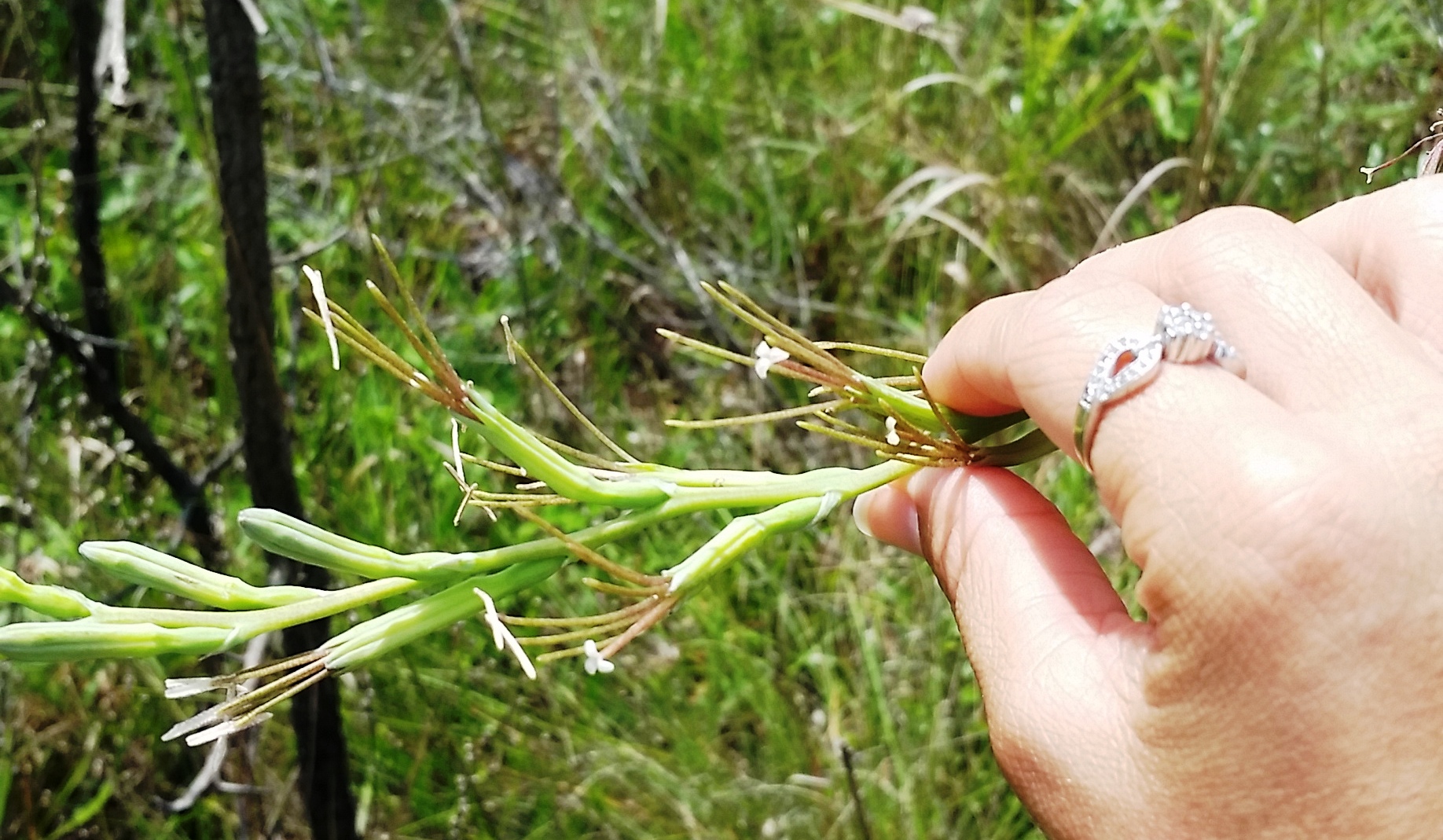Difference between revisions of "Manfreda virginica"
| (33 intermediate revisions by 12 users not shown) | |||
| Line 15: | Line 15: | ||
| binomial_authority = (L.) Salisb. ex Rose | | binomial_authority = (L.) Salisb. ex Rose | ||
| range_map = MANF_VIRG_dist.jpg | | range_map = MANF_VIRG_dist.jpg | ||
| − | | range_map_caption = Natural range of ''Manfreda virginica'' from USDA NRCS [http:// | + | | range_map_caption = Natural range of ''Manfreda virginica'' from USDA NRCS [http://plants.usda.gov/core/profile?symbol=MAVI5 Plants Database]. |
}} | }} | ||
| + | |||
| + | Common names: false aloe, rattlesnake-master, eastern agave, eastern false-aloe<ref name=weakley>Weakley, A.S. 2020. Flora of the Southeastern United States. Edition of 20 October 2020. University of North Carolina at Chapel Hill, Chapel Hill, North Carolina.</ref> | ||
| + | ==Taxonomic notes== | ||
| + | Synonyms: ''Agave virginica'' Linnaeus; ''Manfreda virginica'' (Linnaeus) Salisbury ex Rose; ''Manfreda virginica'' ssp. ''virginica''; ''Polianthes virginica'' (Linnaeus) Shinners<ref name=weakley/> | ||
| + | |||
| + | Varieties: ''Manfreda tigrina'' (Engelmann) Small; ''Manfreda virginica''<ref name=weakley/> | ||
| + | |||
==Description== | ==Description== | ||
<!-- Basic life history facts such as annual/perrenial, monoecious/dioecious, root morphology, seed type, etc. --> | <!-- Basic life history facts such as annual/perrenial, monoecious/dioecious, root morphology, seed type, etc. --> | ||
| − | + | A description of ''Manfreda virginica'' is provided in [http://efloras.org/florataxon.aspx?flora_id=1&taxon_id=242101773 The Flora of North America]. | |
==Distribution== | ==Distribution== | ||
| + | ''M. virginica'' ranges from eastern South Carolina, central North Carolina, southwest Virginia, western West Virginia, southern Ohio, southern Indiana, southern Illinois, and Missouri, south to central peninsular Florida and Texas.<ref name=weakley/> | ||
| + | |||
==Ecology== | ==Ecology== | ||
===Habitat=== <!--Natural communities, human disturbed habitats, topography, hydrology, soils, light, fire regime requirements for removal of competition, etc.--> | ===Habitat=== <!--Natural communities, human disturbed habitats, topography, hydrology, soils, light, fire regime requirements for removal of competition, etc.--> | ||
| − | It | + | This species grows in well-drained or poorly-drained slopes of longleaf pine forests, savannas, mesic pine-hardwood forest remnants, granite flatrocks, diabase glades, limestone and dolomite barrens and glades, xeric woodlands over mafic or calcareous rocks, sandhill woodlands, and dry roadbanks.<ref name="FSU Herbarium">Florida State University Robert K. Godfrey Herbarium database. URL: [http://herbarium.bio.fsu.edu http://herbarium.bio.fsu.edu]. Last accessed: June 2014. Collectors: Robert K. Godfrey, R. Komarek, Loran C. Anderson, and Annie Schmidt. States and Counties: Florida: Leon and Washington. Georgia: Grady and Thomas.</ref><ref name=weakley/> It prefers sandy loam habitats and upland Coastal Plain soils that have little slope and low fertility. <ref name="Miller et al 1999">Miller, J. H., R. S. Boyd, et al. (1999). "Floristic diversity, stand structure, and composition 11 years after herbicide site preparation." Canadian Journal of Forest Research 29: 1073-1083.</ref> Additionally, it thrives in semi-shaded areas to open areas. Associated species include longleaf pine, wiregrass, and hardwoods.<ref name="FSU Herbarium"/> |
| − | |||
===Phenology=== <!--Timing off flowering, fruiting, seed dispersal, and environmental triggers. Cite PanFlora website if appropriate: http://www.gilnelson.com/PanFlora/ --> | ===Phenology=== <!--Timing off flowering, fruiting, seed dispersal, and environmental triggers. Cite PanFlora website if appropriate: http://www.gilnelson.com/PanFlora/ --> | ||
| − | ===Seed dispersal=== | + | ''M. virginica'' flowers from late May through August and fruits from August through October.<ref name=weakley/> |
| − | ===Seed bank and germination=== | + | <!--===Seed dispersal===--> |
| + | <!--===Seed bank and germination===--> | ||
| + | |||
===Fire ecology=== <!--Fire tolerance, fire dependence, adaptive fire responses--> | ===Fire ecology=== <!--Fire tolerance, fire dependence, adaptive fire responses--> | ||
| + | This species is found in annually burned areas<ref name="FSU Herbarium"/> as shown by populations of ''Manfreda virginica'' known to persist through repeated annual burns.<ref>Glitzenstein, J. S., D. R. Streng, R. E. Masters, K. M. Robertson and S. M. Hermann 2012. Fire-frequency effects on vegetation in north Florida pinelands: Another look at the long-term Stoddard Fire Research Plots at Tall Timbers Research Station. Forest Ecology and Management 264: 197-209.</ref><ref>Platt, W.J., R. Carter, G. Nelson, W. Baker, S. Hermann, J. Kane, L. Anderson, M. Smith, K. Robertson. 2021. Unpublished species list of Wade Tract old-growth longleaf pine savanna, Thomasville, Georgia.</ref> | ||
===Pollination=== | ===Pollination=== | ||
| − | + | ''M. virginica'' is pollinated both diurnally and nocturnally, with observations suggesting that bumblebees are the predominant floral visitors.<ref name="Groman and Pellmyr 1999">Groman, J. D. and O. Pellmyr (1999). "The pollination biology of Manfreda virginica (Agavaceae): relative contribution of diurnal and nocturnal visitors." Oikos 87: 373-381.</ref> ''Bombus pennsylvanicus'' and ''Hemaris diffinis'' are critical diurnal pollinators; however, diurnally pollinated plants were observed to produce significantly lower seed set than nocturnally and open-pollinated plants.<ref name="Groman and Pellmyr 1999"/> Hence nocturnal visitors contribute more to ''M. virginica'' reproduction despite frequent diurnal visits.<ref name="Groman and Pellmyr 1999"/> | |
| − | === | + | <!--===Herbivory and toxicology===<--Common herbivores, granivory, insect hosting, poisonous chemicals, allelopathy, etc.--> |
| − | ===Diseases and parasites=== | + | <!--===Diseases and parasites===--> |
| − | ==Conservation and | + | |
| − | == | + | ==Conservation, cultivation, and restoration== |
| + | |||
| + | ==Cultural use== | ||
==Photo Gallery== | ==Photo Gallery== | ||
| + | <gallery widths=180px> | ||
| + | |||
| + | File:Manfreda virginica MSmith 2015.jpg| <center> ''Manfreda virginica'' <p> Photo by Michelle Smith</p><p> at Garcon Point Water Management Area, Pensacola, FL. | ||
| + | |||
| + | </nowiki></gallery> | ||
| + | |||
==References and notes== | ==References and notes== | ||
| − | |||
| − | |||
| − | |||
Latest revision as of 15:42, 15 June 2023
| Manfreda virginica | |
|---|---|

| |
| Photo taken by Gil Nelson | |
| Scientific classification | |
| Kingdom: | Plantae |
| Division: | Magnoliophyta - Flowering plants |
| Class: | Liliopsida – Monocotyledons |
| Order: | Liliales |
| Family: | Agavaceae |
| Genus: | Manfreda |
| Species: | M. virginica |
| Binomial name | |
| Manfreda virginica (L.) Salisb. ex Rose | |

| |
| Natural range of Manfreda virginica from USDA NRCS Plants Database. | |
Common names: false aloe, rattlesnake-master, eastern agave, eastern false-aloe[1]
Contents
Taxonomic notes
Synonyms: Agave virginica Linnaeus; Manfreda virginica (Linnaeus) Salisbury ex Rose; Manfreda virginica ssp. virginica; Polianthes virginica (Linnaeus) Shinners[1]
Varieties: Manfreda tigrina (Engelmann) Small; Manfreda virginica[1]
Description
A description of Manfreda virginica is provided in The Flora of North America.
Distribution
M. virginica ranges from eastern South Carolina, central North Carolina, southwest Virginia, western West Virginia, southern Ohio, southern Indiana, southern Illinois, and Missouri, south to central peninsular Florida and Texas.[1]
Ecology
Habitat
This species grows in well-drained or poorly-drained slopes of longleaf pine forests, savannas, mesic pine-hardwood forest remnants, granite flatrocks, diabase glades, limestone and dolomite barrens and glades, xeric woodlands over mafic or calcareous rocks, sandhill woodlands, and dry roadbanks.[2][1] It prefers sandy loam habitats and upland Coastal Plain soils that have little slope and low fertility. [3] Additionally, it thrives in semi-shaded areas to open areas. Associated species include longleaf pine, wiregrass, and hardwoods.[2]
Phenology
M. virginica flowers from late May through August and fruits from August through October.[1]
Fire ecology
This species is found in annually burned areas[2] as shown by populations of Manfreda virginica known to persist through repeated annual burns.[4][5]
Pollination
M. virginica is pollinated both diurnally and nocturnally, with observations suggesting that bumblebees are the predominant floral visitors.[6] Bombus pennsylvanicus and Hemaris diffinis are critical diurnal pollinators; however, diurnally pollinated plants were observed to produce significantly lower seed set than nocturnally and open-pollinated plants.[6] Hence nocturnal visitors contribute more to M. virginica reproduction despite frequent diurnal visits.[6]
Conservation, cultivation, and restoration
Cultural use
Photo Gallery
References and notes
- ↑ 1.0 1.1 1.2 1.3 1.4 1.5 Weakley, A.S. 2020. Flora of the Southeastern United States. Edition of 20 October 2020. University of North Carolina at Chapel Hill, Chapel Hill, North Carolina.
- ↑ 2.0 2.1 2.2 Florida State University Robert K. Godfrey Herbarium database. URL: http://herbarium.bio.fsu.edu. Last accessed: June 2014. Collectors: Robert K. Godfrey, R. Komarek, Loran C. Anderson, and Annie Schmidt. States and Counties: Florida: Leon and Washington. Georgia: Grady and Thomas.
- ↑ Miller, J. H., R. S. Boyd, et al. (1999). "Floristic diversity, stand structure, and composition 11 years after herbicide site preparation." Canadian Journal of Forest Research 29: 1073-1083.
- ↑ Glitzenstein, J. S., D. R. Streng, R. E. Masters, K. M. Robertson and S. M. Hermann 2012. Fire-frequency effects on vegetation in north Florida pinelands: Another look at the long-term Stoddard Fire Research Plots at Tall Timbers Research Station. Forest Ecology and Management 264: 197-209.
- ↑ Platt, W.J., R. Carter, G. Nelson, W. Baker, S. Hermann, J. Kane, L. Anderson, M. Smith, K. Robertson. 2021. Unpublished species list of Wade Tract old-growth longleaf pine savanna, Thomasville, Georgia.
- ↑ 6.0 6.1 6.2 Groman, J. D. and O. Pellmyr (1999). "The pollination biology of Manfreda virginica (Agavaceae): relative contribution of diurnal and nocturnal visitors." Oikos 87: 373-381.
